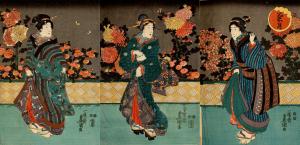Chrysanthemum moon (Kiku-zuki)
Painted by Utagawa Toyokuni III Around 1847-1848 (Kōka 4-Kaei 1) Tokyo Shiryō Collection 07773-C1
Kikuduki refers the ninth month of the lunar calendar. It is one of five seasonal festivals and because the Choyo Festival is held on the ninth day of the ninth month of the lunar calendar, the season when chrysanthemums flourish, it is called the Chrysanthemum Festival. Dressed-up ladies with colorful chrysanthemums in the background are depicted.
The Choyo can be said to be the least familiar annual event amongst the five seasonal festivals in the present time. During the Edo period, however, beginning with each daimyō, people gathered at Edo Castle, held a Choyo ceremony and celebrated it with chrysanthemum sake. Chrysanthemum sake was made with chrysanthemum petals soaked in sake as it was considered to deter evil spirits and prolong people's lives.
Chrysanthemum viewing was a pastime for people living in Edo. The Edo period was a time when guardening boomed. From the early Edo period, the enthusiasm for gardening grew, different types of various species were produced and flower shows for new types called kikuawase (chrysanthemum matching) were also held amongst the people. The display of chrysanthemum dolls (kikuningyo), which was undispensable for the Choyo Festival, was started by a gardener from Somei (present day Komagome in Toshima Ward) during the Bunka era (1804-1818).


